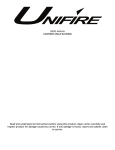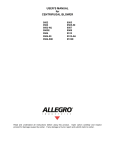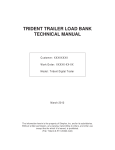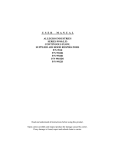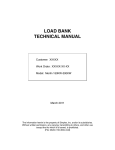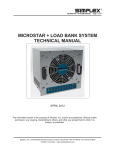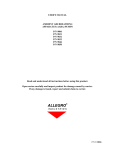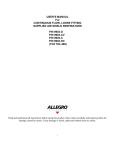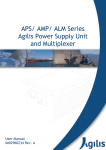Download Allegro Industries 9509-01 User`s manual
Transcript
USER’S MANUAL for AXIAL BLOWERS 8” AC BLOWERS 9513 9513-05 9513-AU 9513-E 9514 9514-05 9514-06 9514-25 9514-25AU 9514-25E 9514-AU 9514-E 9534 9534-15 9534-25 8” DC BLOWERS 9506 9506-01 9506-25 9537 9537-15 9537-25 12” AC BLOWERS 9509 9509-01 9509-50 9509-50AU 9509-50E 16” AC BLOWERS 9515 9515-01 9515-AU 9515-E 9516 20” AC BLOWERS 9525 9525-01 9525-50 9525-E Read and understand all instructions before using this product. Open carton carefully and inspect product for damage caused by carrier. If any damage is found, report and submit claim to carrier. TABLE OF CONTENTS PAGE INTRODUCTION ............................................................................................... 2 DESCRIPTION .................................................................................................. 2 SAFETY PRECAUTIONS ................................................................................. 3-5 WARNINGS AND LIMITATIONS....................................................................... 5-6 OPERATING INSTRUCTIONS ......................................................................... 6-8 SPECIFICATIONS ............................................................................................ 9 MAINTENANCE ................................................................................................ 10 TROUBLESHOOTING ...................................................................................... 11 STORAGE......................................................................................................... 12 CONFINED SPACE .......................................................................................... 12 HAZARDOUS LOCATION INFORMATION ...................................................... 13 FREQUENTLY ASKED QUESTIONS ............................................................... 14-15 WARRANTY...................................................................................................... 16-18 RETURN POLICY ............................................................................................. 17-18 1 INTRODUCTION This manual provides instructions for the use and maintenance of Allegro Industries Axial Blowers. You must read and understand this manual and be trained in the proper use of the equipment before using it in a contaminated atmosphere. There are many federal, state and local codes and regulations governing sales, construction, installation and/or use of products for certain purposes which may vary. Allegro cannot be responsible for how the products are used and installed. Before purchase and use, the buyer must review the product application, and be sure that the product installation and use will comply with those regulations. For more information and assistance on Allegro Industries products, contact Allegro Technical support toll free at 1-800-622-3530 or e-mail at: [email protected] DESCRIPTION Allegro Axial Blowers are designed to offer high output CFM in easy-to-use portable, airover-motor configurations. They are available in outputs from 778 up to 7500 CFM of free air. Axial blowers are available in a range of styles, sizes and power. For Explosion-Proof Blowers, the receptacle should be installed by qualified personnel and is sold separately (P/N 9503-03). Blowers include: 9509 Standard Axial 12” Blower 9509-01 Explosion Proof 12” Axial Blower 9509-50 High Output Axial 12” Blower 9509-50AU High Output Axial 12” Blower* 9509-50E High Output Axial 12” Blower* 9513 Standard Axial 8” Blower 9513-05 Explosion Proof 8” Axial Blower 9513-AU Standard Axial 8” Blower * 9513-E Standard Axial 8” Blower * 9514 Standard Axial 8” Blower with 15’ Ducting Canister 9514-05 Explosion Proof 8” Axial Blower with 15’ Ducting & Canister 9514-06 Explosion Proof 8” Axial Blower with 25’ Ducting & Canister 9514-25 Standard Axial 8” Blower with 25’ Ducting & Canister 9514-25AU Standard Axial 8” Blower with 25’ Ducting & Canister* 9514-25E Standard Axial 8” Blower with 25’ Ducting & Canister* 9514-AU Standard Axial 8” Blower with 15’ Ducting & Canister* 9514-E Standard Axial 8” Blower with 15’ Ducting & Canister* 9515 Standard Axial 16” Blower 9515-01 Explosion Proof 16” Axial Blower 9515-AU Standard Axial 16” Blower* 9515-E Standard Axial 16” Blower* 9516 High Output Axial 16” Blower 9525 Standard Axial 20” Blower 9525-01 Explosion Proof 20” Axial Blower 9525-50 High Output Axial 20” Blower 9525-E Standard Axial 20” Blower* * Models available in 220V/50Hz 2 (cont’d) 9534 9534-15 9534-25 Com-Pax-ial 8” Blower Com-Pax-ial 8” Blower with 15’ Ducting and Canister Com-Pax-ial 8” Blower with 25’ Ducting and Canister The following are available with a 12-volt DC motor, models include: 9506 9506-01 9506-25 9537 9537-15 9537-25 Standard Axial 8” Blower Standard Axial 8” Blower with 15’ Ducting Canister Standard Axial 8” Blower with 25’ Ducting & Canister Com-Pax-ial 8” Blower Com-Pax-ial 8” Blower with 15’ Ducting and Canister Com-Pax-ial 8” Blower with 25’ Ducting and Canister SAFETY PRECAUTIONS DO NOT operate blower until the operator completely comprehends the contents of this manual. The blower is a specialized type of powered equipment, designed for a specific job function and requires adequate and thorough instruction BEFORE it is operated. Each person must receive adequate professional instruction regarding proper operation. Read and understand this User Manual and the material supplied by the motor manufacturer. Refer to OSHA 2207, for job safety and health rules and regulations (1926 and 1910) covering construction. DO NOT set-up or operate a blower without verifying the location classification and match or exceed location requirements for blower type. Certain job site locations may be classified as hazardous because of explosive concentrations of gas, vapor or dust in the atmosphere. The National Electric Code (NEC) divides these locations into Classes and Groups according to the type of explosive agent. For specific information, consult the NEC, Section 500-504 and 510-517. Use Allegro Explosion-Proof Blowers for operation in an explosive or flammable atmosphere that match or exceed location requirements. The use of any other blower not designed for use in a Hazardous Location may result in personal injury or death. DO NOT use an undersized wire size on electrical power cable or extension cords if used. This will adversely limit the starting and load carrying capabilities of the motor. Always use minimum AWG wire sizes for motor branch circuits. Consult the National Electric Code Tables, Article 400, for specific information. DO NOT operate the blower without the inlet and outlet screens properly secured and in place. Replace screens with factory replacements (OEM). The screen grid must comply with current OSHA regulations regarding protective enclosures to prevent personal injury to the operator(s). Ensure the structural integrity of the screens will allow them to serve their protective function. Keep both screens free from obstructions and debris to allow maximum airflow. 3 DO NOT stand directly in front of and/or face the blower outlet. Personal injury may result from debris being thrown from the blower fan at relatively high velocity. DO NOT allow minors to operate the blower. Bystanders, children and animals should not be allowed in the area where a blower is in use. DO implement an operational safety program for this blower, to include but not limited to: instructional requirements for operation, applicable OSHA requirements, local laws and regulations, job site safety and blower maintenance. Operators must be fully instructed regarding the specifics of this safety program. (Ref. 29CFR 1926.21 (b)(2)). DO ensure the blower is in its original, factory configuration and has not been modified. Any modifications may result in potentially dangerous configurations that can lead to property damage and/or personal injury. As well as voiding the manufacturer’s warranty DO ensure operator(s) are in adequate physical condition, mental health and not under the influence of any substance (drugs, alcohol, etc.) which might impair vision, dexterity or judgment. If you have any condition that might be aggravated by strenuous work, check with your doctor before operating the blower. Guard against the possibility of back related injuries. Always use proper lifting techniques when moving or carrying blower. DO wear sturdy and snug fitting clothing. Never wear loose fitting clothing or anything that could become caught on controls or moving parts. Wear long pants to protect your legs. To improve your grip and protect your hands, wear heavy duty, non-slip gloves. Wear steel-toed safety boots with non-slip soles. Sneakers or other similar type shoes do not provide adequate protection. DO wear an approved safety hard hat. Noise, generated by the blower, may damage your hearing. Wear sound barriers (ear plugs or ear mufflers). Continuous and regular operators should have their hearing checked regularly. DO a visual inspection of the blower and check for damaged, worn, loose and/or broken parts. Ensure all safety devices are operable and information decals are readable. Ensure the blower and all related accessories are in good mechanical condition before use. DO ground the blower motor securely. Ensure the “grounding” wire and/or device is properly grounding the motor. Failure to properly ground the motor may cause an electrical shock and/or electrocution, resulting in personal injury or even death. DO use a ground fault circuit interrupter (GFCI). A GFCI is a safety device that disconnects power from a circuit to a load when a potentially dangerous condition occurs. The GFCI acts like a fast-acting fuse or circuit breaker, sensing small imbalances in the circuit caused by current leakage, and shutting off electricity within 25mS (milliseconds). Use of a portable GFCI gives on-the-job protection from electrical 4 shock hazards caused by ground faults in commercial, industrial and residential applications. Electrically driven blowers are designed to operate ONLY from a grounded 115 volt AC, 60Hz or 220V/60Hz (select models w/220V/50Hz), single phase power source. All electrical wiring installations and connections must comply with all applicable NEC statutes and with all applicable local codes and practices. (For specific information, consult the NEC publications and OSHA publications 210-22D for construction sites and 555-3 for marina’s or for use around any area containing water.) DO know where the controls are, how they operate, and how to stop the blower in an emergency. DO place the blower on secure footing to prevent it from shifting while in use. Such movement can cause injury to the operator(s) or damage to the blower itself. DO ensure blower is operated in a horizontal position to meet the enclosure definition. The blower is designed for operation in job site areas that are reasonably dry, clean and provide for a continuous, dynamic source of air for cooling the motor. Any questions about operating environments, contact the Allegro Technical Support at 1-800-6223530, or e-mail at [email protected], before using the blower. WARNINGS AND LIMITATIONS Flow rate testing performed by the Colorado Engineering Experiment Station, Inc. and Allegro Industries. The Blowers were tested per AT&T Standard EL2723/PL2709 in a chamber built in accordance with AMICA Standard 210-67. Tests performed with a single, 8 inch (203mm) diameter x 15 feet (7.6m) flexible, reinforced duct connected to the blower outlet (with the exception of Free Air results). The published flow rates are intended to serve only as a reference. Manufacturing tolerances and specific operating parameters will affect the overall flow rate(s) for each particular blower. Actual flow rate will decrease when the total length of the ducting is increased more than 15 feet (7.6m). Actual flow rates may change if blower is used with ducts manufactured and/or supplied by other sources. CAUTION! The final working procedure for any job application involving the use of the blower must be individually determined after careful analysis of all factors and/or conditions present. The nearest OSHA office is a valuable source for applicable information regarding the operation of the blower. 5 DANGER! Before using the blower, check all applicable federal, state, industry and local regulations regarding the use of flame resistant and/or self extinguishing duct materials for the intended job applications. It is the responsibility of the owner(s) and/or operator(s) to determine that the duct material in use for the job application meets all applicable fire code and OSHA requirements DANGER! Always stop the motor and disconnect the power source to prevent accidental starting and/or the possibility of receiving an electrical shock. DANGER! Never enter a manhole or confined work area, until it has been determined to be safe for entry and tested with appropriate gas detection equipment and ventilated for a minimum of five (5) minutes with the blower at maximum speed. OPERATION Use of Duct: 1. Operate the blower upwind from the work location and with the air inlet facing into the relative wind to maximize air flow. 2. The Allegro flexible ducts are for use with Allegro blowers. a. All are of the collapsible, reinforced design. b. Each duct is supplied with a nylon strap to secure each end to the blower and or a duct connector. c. When using statically conductive ducting, the integrated grounding wire must be properly: i. Grounded to the blower chassis. ii. Linked to any additional grounding wire or duct used. 3. It is recommended the total length of duct does not exceed 100 feet. 4. To join two sections of duct, use a duct-to-duct connector. 5. Pull duct sleeve over the outlet port at least six (6) inches and secure the duct to the blower with the nylon clamping strap and tighten securely. 6. For exhaust (air blowing) operations, connect the duct to the blower outlet. a. The duct can be one of two types: i. Collapsible, non-reinforced. ii. Collapsible, flexible, reinforced. 6 7. For extraction (air evacuation) operations, connect the duct to the blower inlet. a. The duct must be of the reinforced type to prevent the vacuum force generated by the blower’s suction from collapsing the duct. b. For the Com-Pax-ial and 12” Axial blowers, duct can be secured on either side of blower. c. For the 8” 9513 Series Axial blowers an optional inlet adapter (P/N: 9500-03) must be used i. Remove the inlet grill. ii. Attach the inlet adapter and secure. d. For the 16” & 20” Standard or 16” & 20” Explosion Proof Axial blower. i. Remove the ring flange from the exhaust and relocate to the inlet side and secure. ii. You may purchase an additional ring flange for dual extraction/ventilation use. Part No’s needed are: 9515-03R 16” Blower Ring adapter 1ea 9525-03R 20” Blower Ring adapter 1ea 9800-68 Machine screw 3ea 9500-63 Washer 3ea DANGER! Before using the blower, check all applicable federal, state, industry and local regulations regarding the use of flame resistant and/or self extinguishing duct materials for the intended job applications. It is the responsibility of the owner(s) and/or operator(s) to determine that the duct material in use for the job application meets all applicable fire code and OSHA requirements. WARNING! GENERATOR USAGE It is important to use the proper size generator when power a blower. Using an undersized generator may cause damage to the blower motor. Please refer to the Specifications section for a minimum generator recommendation. Use of a generator at the minimum recommended output with additional devices can cause decreased output or blower stoppage. 7 Voltage and Power Selection: 1. The voltage, frequency and phase of the power supply must be consistent with the motor nameplate rating. a. The motor will operate satisfactorily on voltages within 10% of the nameplate value or frequency within 5%. The combined variation must not exceed 10%. 2. The Allegro blowers are designed to operate from a grounded, 115 VAC, 60Hz or 220V/60Hz, single phase power source. a. Select models are available in a 220V/50Hz. single phase configuration. b. It is crucial to the performance of the blower that the proper power source is selected. 3. Standard 115 volt blowers are supplied with a P5-15 plug or a twist-lock NEMA plug (excluding 220V/50Hz blowers) a. Do not change or alter the plug as this will affect the performance of the blower. b. Operation from an inadequate power source or use of incorrect electrical plug may result in property damage and/or personal injury. 4. To determine maximum length of extension cord, when used with a blower, refer to the National Electric Code Tables, Article 400. CAUTION When choosing an extension cord, ensure that the cord is not an undersized wire. As a “Rule of Thumb”, the diameter of cable for an extension cord should be larger than the diameter of the cord being plugged into it. Consult the NEC (National Electrical Code) Tables for specific cord size information. 8 SPECIFICATIONS SIZE 8” 8” 8” 8" 8” 8" 8” 12” 16” 20” MINIMUM GENERATOR SUGGESTION PART No HP AMP VOLTAGE WEIGHT CFM (FREE AIR) 9513 1/3 3 115 VAC 19 lbs. 1275 2 KW * 9513AU/-E 1/3 1.5 220 V/50 Hz 19 lbs. N/A - 9514 1/3 3 115 VAC 32 lbs. N/A 2 KW * 9514AU/-E 1/3 1.5 220 V/50 Hz 32 lbs. N/A - 9514-25 1/3 3 115 VAC 46 lbs. N/A 2 KW * 9514-25AU/-25E 1/3 1.5 220 V/50 Hz 42 lbs. N/A 9513-05 1/3 2.2 115 VAC 31 lbs. 890 2 KW * 9514-05 1/3 3.3 115 VAC 49 lbs. N/A 2 KW * 9514-06 1/3 3.3 115 VAC 57lbs. N/A 2 KW * 9534 1/3 3.6 115 VAC 17 lbs. 778 2 KW * 9534-15 1/3 3 115 VAC 34 lbs. N/A 2 KW * 9534-25 1/3 3 115 VAC 37 lbs. N/A 2 KW * 9506 9506-01 1/3 1/3 13 13 12 VDC 12 VDC 18 lbs. 31 lbs. 1150 N/A 9506-25 1/3 13 12 VDC 37 lbs. N/A N/A N/A N/A 9537 1/4 13 12 VDC 16 lbs. 796 N/A 9537-15 1/4 13 12 VDC 31 lbs. N/A N/A 9537-25 1/4 13 12 VDC 36 lbs. N/A N/A 9509 1/3 3.6 115 VAC 27 lbs. 1763 2 KW * 9509-01 1/3 3.3 115 VAC 33 lbs. 1636 2 KW * 9509-50 1/2 6.0 115 VAC 40 lbs. 2202 2 KW * 9509-50AU/-50E 1/2 3.2 220 V/50 Hz 27 lbs. N/A 9515 1/2 7.2 115 VAC 47 lbs. 3400 2 KW * 9515-01 1/2 8.2/4.1 115 or 230 VAC 67 lbs. 2900 2 KW * 9515AU/-E 1/2 3.6 220 V/50 Hz 51 lbs. N/A - 9516 2 21/10.5 115 or 230 VAC 74 lbs. 5500 6 KW * 9525 1/2 7.2 115 VAC 56 lbs. 4650 2 KW * 9525-01 1/2 8.2/4.1 115 or 230 VAC 75 lbs. 4650 2 KW * 9525-50 2 21/10.5 115 or 230 VAC 83 lbs. 7500 6 KW * 9525-E 1/2 3.1 220 V/50Hz 75 lbs. N/A - - - *This is the minimum tested wattage per each specific motor, by its horsepower. If more than one unit is being powered, the generator output must be increased accordingly. 9 MAINTENANCE Maintenance & Repair: Use only genuine Allegro approved, replacement parts for maintenance and repair. Use of parts manufactured by others can result in property damage and/or personal injury. Follow the service instructions as outlined in the Maintenance section of this Users Manual. Always properly maintain the blower. Frequently check all fasteners and individual parts. Built-in safety features are effective only if they are maintained in good working condition. Keep the blower clean and properly serviced. Heavy accumulations of dust and dirt will result in overheating and premature failure of the blower motor. Clean the motor surfaces and all ventilation openings periodically. Always stop the motor and disconnect the power source to prevent the accidental starting and/or the possibility of receiving an electrical shock working on the blower. Do not energize the electric motor with the shaft key exposed on the open shaft. Personal injury can result from being struck by a shaft key thrown from the motor shaft. DANGER! Always stop the motor and disconnect the power source to prevent the accidental starting and/or the possibility of receiving an electrical shock. Do not attempt any maintenance or repair work not described in this Users Manual! Electric Motor Maintenance: The electric motor is capable of operating for many years with minimum maintenance. Before attempting to service the motor, disconnect the blower from the power supply. Clean the motor surfaces and ventilation openings periodically, preferably with a vacuum cleaner. Heavy accumulation of dirt and lint will result in overheating and premature failure of the motor. The electric motor is equipped with ball bearings, and under normal service and ambient temperatures, should not require re-lubrication for 9 to 10 years. If you feel that the motor requires re-lubrication, contact the local service representative of the motor manufacturer for specific information. 10 TROUBLESHOOTING Electric Motor: TROUBLE CAUSE WHAT TO DO Blown Fuses Replace fuses at least 125 % of nameplate amperes. Improper current supply Ensure the power supplied agrees with motor nameplate and load factor. Improper line connections Check connections with diagram supplied with motor. Open circuit in winding or starting switch Indicated by humming sound when switch is closed. Repulsion induction motors may spark at brushes. Check for loose wiring connections; also see if starting switch inside motor is closed. Mechanical failure Ensure motor and drive turn freely. Check bearings and lubrication. Short circuited stator Motor may be overloaded Indicated by blown fuses. Motor must be rewound. Reduce load. Defective capacitor Check for short circuit, grounded or open capacitor, replace if necessary. Overloaded motor Low motor voltage Reduce load. See that nameplate voltage is maintained. Open circuit Fuses blown, check overload, relay, stator and resetbuttons. Motor runs and then dies Power failure Check for loose connections to line, to fuses and to control. Motor does not come up to speed Open primary circuit Locate fault with testing device and repair. Motor takes too long to accelerate Excess loading Poor circuit Applied voltage too low Reduce load. Check for high resistance. Get power company to increase power tap. Wrong rotation Wrong sequence of phases Reverse connections at motor. Overload Dirt build-up, insufficient ventilation. May have one phase open Reduce load Unbalanced terminal voltage Check for faulty leads, connections. Shorted stator coil Faulty connection High voltage Low voltage Repair and then check wattmeter reading. Indicated by high resistance. Check terminals of motor with a voltmeter. Check terminals of motor with voltmeter. Motor misaligned Realign. Weak foundations Strengthen (tighten) base. Fan rubbing Fan striking housing insulation Rotor or fan wheel unbalance Remove or clear interference. Motor Fails to Start Motor Stalls Motor overheats while running under load Motor vibrates after corrections have been made Scraping noise Noisy operation Clean Ensure all leads are well connected. Clear fan. Rebalance. 11 STORAGE The proper procedure for long-term storage of the blower will protect it against the effects of corrosion and damage. If the blower is not to be operated for a period of 30 days or more, proceed to store as follows: 1. Clean all accumulated dirt and grease from the blower using an appropriate cleaner. 2. Check parts for wear or damage. Make the necessary repairs. 3. Apply a light coat of dry film lubricant to the blower hub and shaft to prevent rust formation. 4. Store the blower indoors. If the blower must be stored outdoors, protect it from the elements with a suitable enclosure or storage. CONFINED SPACE APPLICATIONS DANGER! Refer to local and federal OSHA Confined Space Laws and Regulations. CAUTION! The final working procedure for any job application involving the use of the blower must be individually determined after careful analysis of all factors and/or conditions present. The nearest OSHA office is a valuable source for applicable information regarding the field use of the blower. 12 Hazardous Location Requirements: DANGER! The “Hazardous Location Plug” supplied with Allegro Explosion Proof Blowers, must be used with an approved Hazardous Location Receptacle for operation in a specific Hazardous Location Atmosphere. Use of any Non-Hazardous Location Atmosphere receptacle in a Hazardous Location could create a random spark. Such an occurrence can be the ignition source of an explosion, resulting in property damage and/or personal injury or death. Only Statically Conductive Ducting may be used with Explosion Proof Blowers. The Allegro Explosion Proof Blowers are rated to be used in the following hazardous locations: Blower Class Division Group 9513-05 9514-05 I 1&2 C&D 9514-06 9509-01 9515-01 II 1&2 F&G 9525-01 Verify your location classification. The National Electric Code divides these locations into Classes and Groups according to the type of explosive gas/agent, which may be present. For specific information on Hazardous Location requirements, consult the National Electric Code, Section 500 through 517, or qualified personnel. For reference, see OSHA website @ http://www.osha.gov/doc/outreachtraining/htmlfiles/hazloc.html. The Hazardous Location plug and receptacle must be used and properly wired using a conduit system to the power source. WARNING ! Hazardous location receptacle, or socket, must be installed by qualified personnel. DANGER! Hazardous location equipment may be required in any area where the presence of flammable gases, vapors or finely pulverized dusts in the atmosphere is sufficient to create a threat of explosion or fire. It may also be required where easily ignitable fibers of flyings are present. WARNING! Explosion-proof blowers MUST BE used with statically conductive ducting. 13 FREQUENTLY ASKED QUESTIONS ON BLOWERS Q: What is the main difference between the Axial and the Centrifugal Blowers? A: The Centrifugal Blowers have the motor on the outside of the housing. The centrifugal design allows them to push against greater dynamic back-pressure (higher static pressure) with extended lengths of ducting compared to axial blowers. The Axial Blowers have housed motors making them more compact, portable and less expensive. They offer higher CFM in a free air configuration. Q: How do I choose the correct blower to ventilate an area? A: You first need to determine the total volume (cu.ft.) of the space to be ventilated. We recommend using a blower that is capable of 20 exchanges of air per hour. You can find this information on our website (www.allegrosafety.com) click on the Blower Selection icon (right hand side) to calculate the recommended CFM requirement and find product matches. Also in the Blower section, click on Ventilation Information (for a chart) or Blower Selection (same as above icon). For further assistance, contact Allegro Technical Support at (800) 622-3530.or [email protected] . Q: Is it better to positively ventilate or to evacuate air? A: Any Confined Space must be positively ventilated; you may evacuate when fumes are being generated in a specific location. (e.g. welding, grinding, etc.) Q: How do I know an Explosion Proof (EX) Blower meets the Class, Division, and Group for my hazardous confined space? A: All of our EX Blowers are shipped with an approved Hazardous location motor. Each blower is stamped with the approved Class, Division, and Group. They are also supplied with the appropriate antispark fan wheel, and plug. Q: Can you place the Explosion Proof Blower in an Explosive Atmosphere? A: Yes, however the blower should be at least five feet away from the entrance, in order to bring fresh air in and not just to re-circulate the contaminated air. (It is recommended that the area is monitored) Q: Why do I need the Explosion Proof receptacle and plug with the Explosion Proof Blower? A: The receptacle ( P/N 9503-03, sold separately) must be hard-wired to your power source (e.g. conduit, flexible conduit) to meet explosion-proof standards. If you modify any part of the blower, cord, plug, and/or receptacle, you will void the explosion proof certification. Q; Can I use an explosion proof blower with a standard extension cord and/or receptacle? A: If the plug can be used without alteration, the explosion proof blower may be used in a non-hazardous area. Q: Can the Air Driven Blower be used in an explosion proof atmosphere with statically conductive ducting? A: Yes, keeping in mind that it has steel parts and the unit is not certified as intrinsically safe. Q: Can I use a blower to evacuate welding fumes? A: Yes, you can have ducting directed at the working area with the blower in the extracting configuration. Q: Why do I need to use statically conductive ducting with EX Blowers? A: As a requirement for hazardous locations, this ducting is coated with Neoprene, which resists static charge build up. It also is integrated with a grounding wire, to maintain the ground throughout your system. A duct-to-duct connector may be used if the ground wire is continuously attached to a ground. Q: Can I connect two pieces of ducting together? A: Yes, you can use the optional duct-to-duct connector, P/N: 9500-01 (8"), 9550-01 (12”), 9600-01 (16"), or 9650-01 (20”). Q: What’s the maximum length of ducting? A: Maximum duct lengths will vary for each blower and environment. Generally, increasing lengths will decrease flow rates. Contact Allegro Technical Services (800 622-3530 or email [email protected] for more information. Q: Can I use two blowers, one to ventilate and another to extract air, in the same space? A: Yes, when used with ducting this will help concentrate the exchange of fresh air in a specific area of a given space, but will not significantly increase the overall air exchange. Q: Will the blower output decrease if I add additional ducting? A: Yes, the output will decrease with any addition of ducting or addition of bends in the ducting. Q: Are the reductions in output directly related to the length in ducting? A: No, there are several variables that will affect the total output of the blower. The biggest drop in output will occur after the first addition of ducting, thereafter the reductions are smaller. The same holds true for the number of bends. Q: What is the maximum temperature the ducting can withstand? A: The maximum working temperature for standard ducting is 180°F and Statically Conductive ducting 250° F. Q: Can I use the 12” or 16" Blower with 8" ducting? A: Yes, the optional Adaptor Reducer, P/N 9509-03 (12”) can be used only with the 9509-50 High Output blower. The P/N: 9600-50 (16”), can only be used with the Standard 16" blower (P/N 9515) and the 16" Explosion Proof blower (P/N 9516-01). It is not recommended for the High Output blower 9516. Q: Can you draw air with all Allegro blowers? A: Yes, you can relocate the flange on the 9515 & -01 (16") and 9525 & -01 (20”) Axial blowers. It is not recommended for the High Output 9516 (16”) or 9525-50 (20”). You may install an optional inlet adapter on the 8" Axial blowers. The Plastic and Metal COM-PAX-IALS have an inlet and outlet port, the canister can attach to either side of blower for suction or ventilation. The ducting can attach to the inlet or outlet port for extraction or ventilation on the 8” and 12” and all centrifugal blowers. Q: Can a blower be placed vertically above a manhole? A: Yes, if it is supported safely with proper ingress/egress, vibration, movement, and weight mitigated. Q: Why is my blower tripping the circuit breaker? A: Two main factors can cause this: 1) Ensure there is proper current to the blower. a) Check circuit breaker, it must be of appropriate amperage (load). b) Check the voltage on the panel and the blower. c) Check for condition of electrical cord and/or extension cord, as well as extension cord gauge and length. 2) Check for proper fan operation. a) Ensure the fan is not rubbing against the housing. b) Check for foreign material build-up inside housing. This might prevent fan from turning. c) Check for any rust on shaft or damaged fan blades. Q: Can I convert my AC (115V) powered blower into DC (12V) powered blower? A: No, the motors can not be used for both applications or converted. There are many AC to DC inverters on the market that can be purchased, which will let you adapt an AC blower (115V) to your car’s battery (12V) for power. Q: Do you have parts listings on your website? A: Parts are located at each product page (if applicable) or for all Parts Listing, in the tab on the lower navigation bar. For more information and assistance on Allegro Products, check the website @ http://www.allegrosafety.com/, contact Allegro Technical Service Department at (800) 622-3530, or email [email protected]. 15 ALLEGRO INDUSTRIES LIMITED WARRANTY AND WARRANTY SERVICE AND RETURN POLICY Express Warranty The warranty obligations of Allegro Industries (“Allegro”) are limited to the terms set forth below: All products, equipment and parts (collectively “Product” or “Products”) sold by Allegro, either directly to its customers, or indirectly from its suppliers or distributors to their customers, are warranted, to the original end-user purchaser who/that receives the original, unaltered Product (“Purchaser”), to be free from defects in workmanship and materials under normal use for one (1) year from the date of sale to the Purchaser, when installed properly and used normally and in accordance with written operation instructions, if any (“Limited Warranty”) (“Warranty Period”). No other express or implied warranty is given, and no affirmation of Allegro, by words or action, will constitute a warranty. This Limited Warranty is conditioned upon proper use of the Product by Purchaser and applies only to Products manufactured by or for Allegro that can be identified by the Allegro trademark, trade name or logo affixed to them. This Limited Warranty does not apply to or cover: (a) defects or damage caused by or resulting from external causes including, but not limited to, accident, carrier handling, improper packaging in shipment; abuse, misuse, neglect, unusual physical stress, cosmetic damage, flood, fire, earthquake or other natural disasters; (b) normal wear and tear; (c) any modification of any part of the Product; (d) damage caused by using the Product outside the permitted or intended uses described by Allegro or written instructions; (e) malfunctions resulting from the use of the Product in conjunction with accessories, products or ancillary/peripheral equipment not furnished or approved by Allegro; (f) defects or damage caused by improper testing, operation, maintenance, installation or adjustment; or (g) defects or damage caused by installation and/or service performed by anyone who is not authorized by Allegro. Each Purchaser agrees and acknowledges that the use, installation and/or operation of the Products shall be at Purchaser’s own risk and may result in severe injury, death and/or damage to persons or real and/or personal property. No Allegro supplier, distributor, officer, agent or employee is authorized to make any modification, extension, change or amendment to this Limited Warranty without the express prior written consent and authorization by the President of Allegro. Allegro reserves the right to make improvements or changes to its Products at any time, without incurring any obligation to Purchasers, suppliers, distributors or customers who/that previously purchased Products directly or indirectly from Allegro. EXCEPT AS SET FORTH IN THE EXPRESS WARRANTY CONTAINED HEREIN, PURCHASER TAKES THE PRODUCT “AS IS.” THERE ARE NO EXPRESS OR IMPLIED WARRANTIES OR CONDITIONS BEYOND THOSE STATED IN THIS LIMITED WARRANTY STATEMENT. ALLEGRO DISCLAIMS ALL OTHER 16 WARRANTIES AND CONDITIONS, EXPRESS OR IMPLIED, INCLUDING, BUT NOT LIMITED TO, THE WARRANTY OF MERCHANTABILITY OF THE PRODUCTS AND THEIR FITNESS FOR ANY PARTICULAR PURPOSE. NOTHING CONTAINED IN ANY WRITTEN INSTRUCTIONS OR WRITTEN INSTRUCTION OR OPERATION MANUAL OR CATALOG SHALL BE CONSTRUED TO CREATE A WARRANTY OF ANY KIND WHATSOEVER WITH RESPECT TO THE PRODUCT. IN ADDITION, TO THE FULLEST EXTENT PERMISSIBLE BY APPLICABLE LAW, ALLEGRO SHALL NOT BE LIABLE FOR ANY INJURY OR DAMAGE TO PERSONS OR PROPERTY OF ANY KIND, OR FROM ANY LOSS OF TIME, INCONVENIENCE, OR LOSS OF USE, INCLUDING ANY CONSEQUENTIAL, INCIDENTAL OR SPECIAL DAMAGES ARISING DIRECTLY OR INDIRECTLY OUT OF OR IN CONNECTION WITH THE USE, INSTALLATION AND/OR PERFORMANCE OF THE PRODUCT OR PRODUCTS, WHETHER SUFFERED BY SUPPLIER, DISTRIBUTOR, CUSTOMER, PURCHASER OR ANY OTHER PARTY, AND REGARDLESS OF THE LEGAL THEORY UPON WHICH THE CLAIM IS BASED, EVEN IF ALLEGRO HAS BEEN ADVISED OF THE POSSIBILITY OF SUCH DAMAGES. WITHOUT OTHERWISE LIMITING THE FOREGOING, IN NO EVENT SHALL RECOVERY OF ANY KIND AGAINST ALLEGRO BE GREATER IN AMOUNT THAN THE PURCHASE PRICE OF THE PRODUCT. THIS WARRANTY GIVES YOU LIMITED SPECIFIC LEGAL RIGHTS. Warranty Service and Return Policy during Warranty Period The following requirements must be followed before returning any Product or Products to Allegro: 1. All Purchasers must obtain a Return Merchandise Authorization Number (“RMA#”) before returning any Product to Allegro. Allegro will refuse to accept any Product returned that does not have the RMA# clearly marked on the outside of the package or box. The Purchaser may obtain this RMA# by telephoning Allegro’s Customer Service number at (800) 622-3530, or by requesting it in writing by mailing the written request to Allegro Industries, 1360 Shiloh Church Road, Piedmont, South Carolina 29673, or by faxing the written request to Allegro Industries at (800) 362-7231. 2. Upon Allegro’s issuance of RMA # to a Purchaser, the Purchaser must decontaminate and clean the Product to remove any hazardous materials which may have settled on the Product during use. Allegro reserves its rights to refuse, and will refuse, to accept any Product suspected of being contaminated and/or containing any dangerous chemical(s) or material(s), and will return that Product or those Products to the Purchaser, freight collect. 3. All Purchasers must return the Product or Products to Allegro freight prepaid, with the RMA# clearly marked on the outside of the box or package. Each Product to be returned should be packaged in its original Product packaging materials or equivalent, and be well padded, to prevent damage when in transit, and should be adequately insured by Purchaser. All Purchasers must bear the risk of loss of the Product during transit from Purchaser to Allegro. Inside the Product’s package, please enclose your name, address, and telephone number, a description of the problem and a model and/or serial number for each Product returned. 17 Upon Allegro’s receipt of a returned Product from a Purchaser that meets the above requirements, Allegro will determine in its sole discretion whether the Product is defective. If Allegro determines that the Product is not defective and/or does not meet the terms of this Limited Warranty, Allegro will return the Product to the Purchaser freight collect. If Allegro determines that the Product is defective, Allegro will determine in its sole discretion whether to repair or replace the defective Product covered by this Limited Warranty. Each Purchaser’s sole and exclusive remedy for defects in Products covered by this Limited Warranty is limited to Allegro’s correction of the defect by repair or replacement. 5. Authorized returns of saleable merchandise, other than shipments made in error by Allegro, will be subject to a 20% restocking charge. Warranty Terms This Limited Warranty represents the complete and exclusive agreement covering this subject matter between Allegro and Purchaser and supersedes any prior agreements and/or communications regarding the subject matter hereof. The terms of this Limited Warranty shall be governed and construed in accordance with the laws of the State of California, without regard to any conflict of law principle that would result in the laws of any other jurisdiction governing this Limited Warranty. Any action or proceeding arising out of this Limited Warranty shall be litigated in the California Superior Court located in Orange County, California. Each Purchaser purchasing any Product from Allegro, directly or indirectly, shall be deemed to consent and submit to the jurisdiction of the state court located in Orange County, California. If any term or provision contained in this Limited Warranty is determined to be unenforceable in any respect, the enforceability of the term or provision in any other respect and of the remaining terms and provisions of this Limited Warranty shall not be impaired. This Limited Warranty shall not extend to anyone other than the original Purchaser of the Product(s) and shall be Purchaser’s exclusive remedy. Each Purchaser acknowledges that this Limited Warranty will always be construed to be limited by its terms to the greatest extent as the law permits. UM004 Rev. P 02/14/12 DCN #D0374 18



















